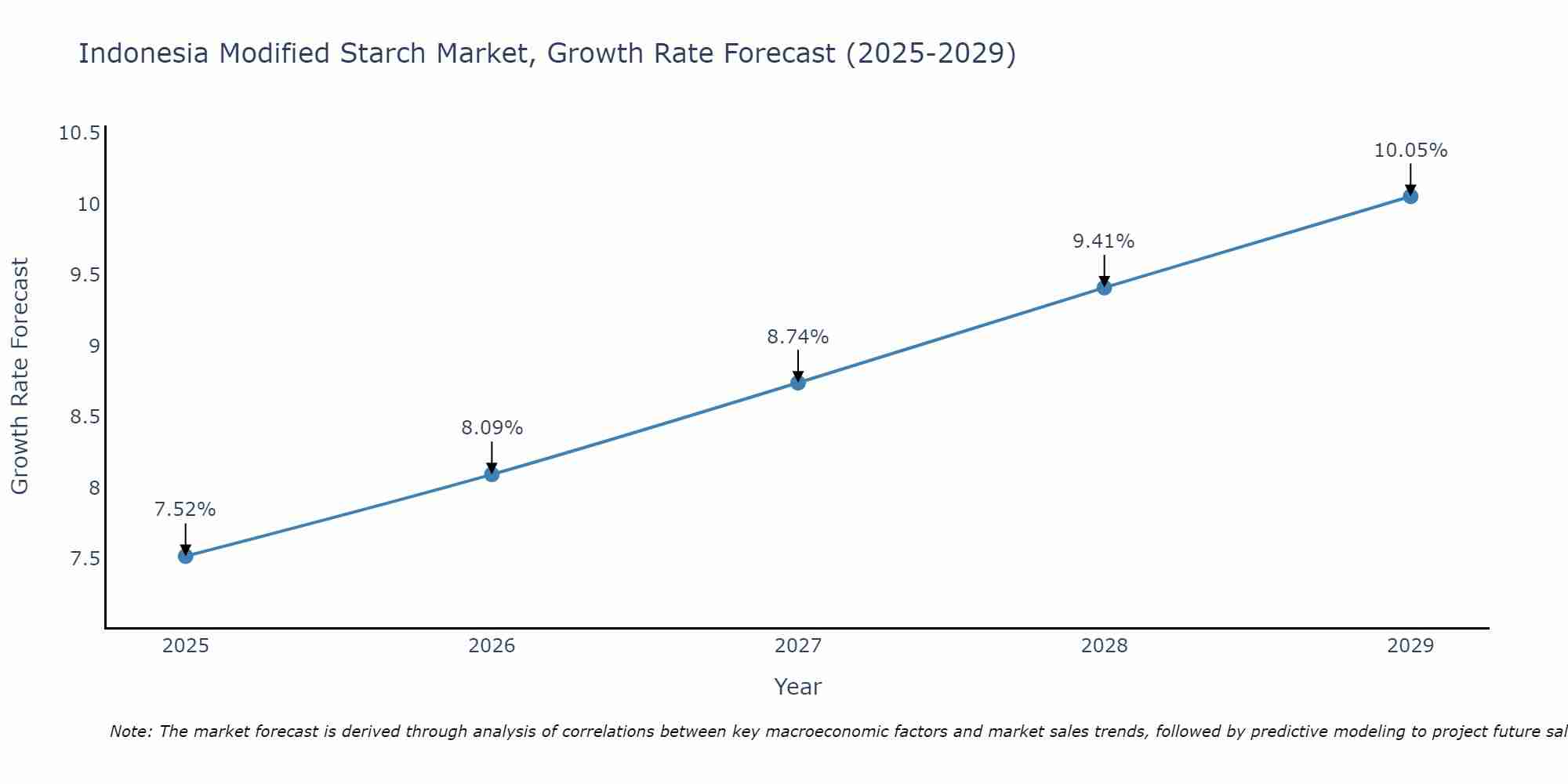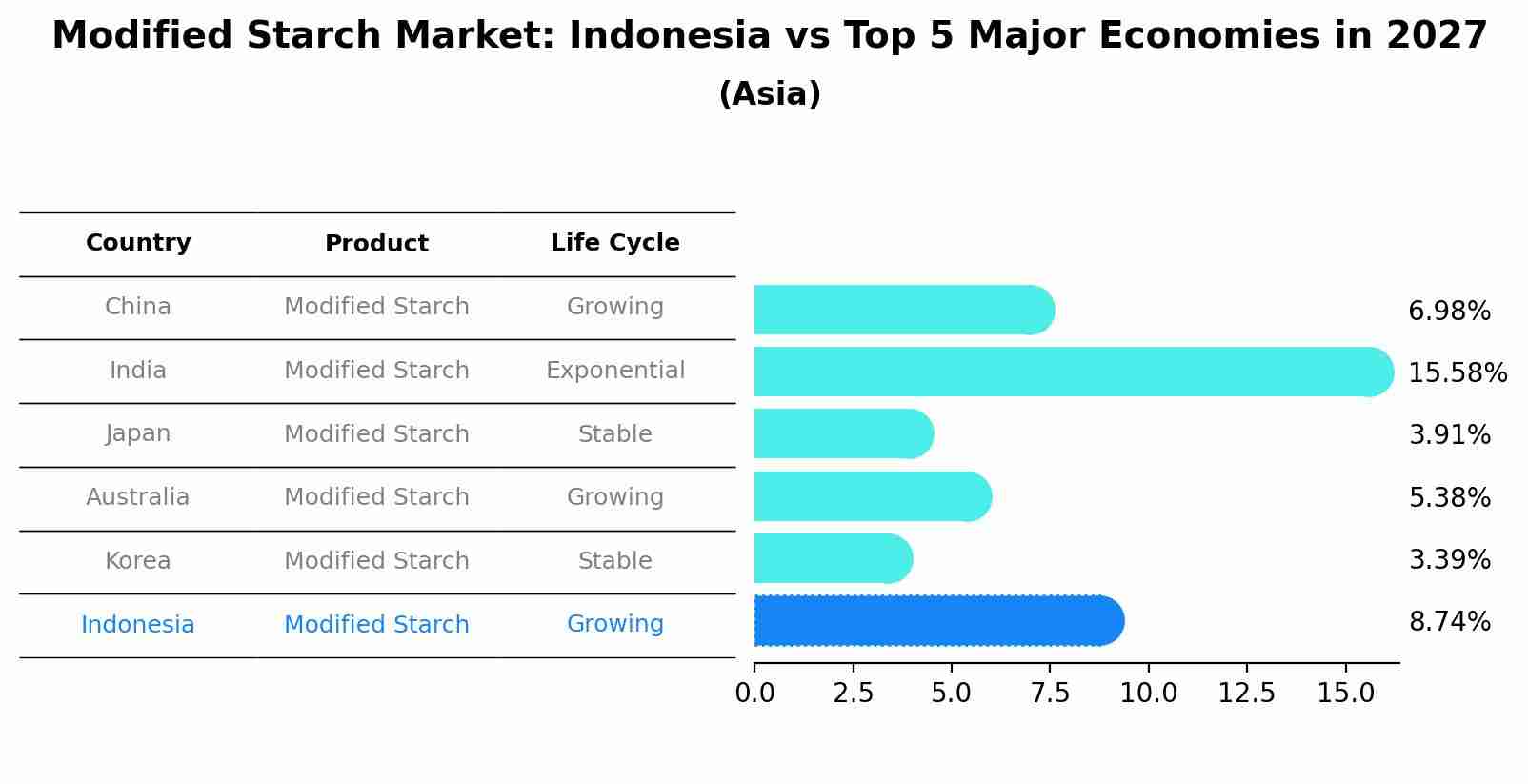Indonesia Modified Starch Market | Companies, Growth, Industry, Outlook, Share, Analysis, Trends, Revenue, Value, COVID-19 IMPACT, Size & Forecast
| Product Code: ETC170147 | Publication Date: Jul 2023 | Updated Date: Aug 2025 | Product Type: Market Research Report | |
| Publisher: 6Wresearch | No. of Pages: 70 | No. of Figures: 35 | No. of Tables: 5 | |
Indonesia Modified Starch Market Size Growth Rate
The Indonesia Modified Starch Market is poised for steady growth rate improvements from 2025 to 2029. From 7.52% in 2025, the growth rate steadily ascends to 10.05% in 2029.

Modified Starch Market: Indonesia vs Top 5 Major Economies in 2027 (Asia)
The Modified Starch market in Indonesia is projected to grow at a growing growth rate of 8.74% by 2027, within the Asia region led by China, along with other countries like India, Japan, Australia and South Korea, collectively shaping a dynamic and evolving market environment driven by innovation and increasing adoption of emerging technologies.

Indonesia Modified Starch MarketSynopsis
Modified starch is a form of processed food additive, produced by the chemical and physical modification of native starches from corn, wheat, potato or tapioca. Modified starches offer improved functionality over unmodified starch in terms of viscosity, stability and freeze-thaw performance. In Indonesia modified starch is used extensively in bakery products, soups & sauces and snacks to improve texture, shelf life and mouthfeel.
Market Trends
In recent years there has been increasing demand for healthy food ingredients among Indonesia consumers which has resulted in growing demand for modified starches as they are considered to be healthier than traditional artificial additives. Furthermore the use of modified starch as a thickening agent has also gained popularity within the Indonesia market due to its ability to replicate the textural properties offered by animal proteins while maintaining product quality without adding fat content or calories. Additionally more manufacturers have started using organic certified versions of modified starch such as cornstarch which adds value to their products and helps them differentiate themselves from competitors.
Market Drivers
The key drivers for growth in the Indonesia modified starch market include an increase in consumer awareness regarding health benefits associated with natural additives; rise in disposable incomes coupled with rapid urbanization; increasing demand for convenience foods such as instant noodles; expanding ecommerce sector leading to greater availability of these products; innovation within product portfolios catering towards specific needs such as gluten free variants etc.; along with a shift towards plant based proteins rather than animal based ones providing further opportunities for growth.
COVID-19 Impact on the Market
The outbreak of the COVID-19 pandemic has had a negative impact on the modified starch market in Indonesia. The pandemic has caused disruption in trade, supply chain activities and manufacturing processes, which have affected the demand for modified starches in food & beverage applications. Additionally, the lockdown imposed by government to contain virus spread resulting into closure of hotels, restaurants and other catering services that are major consumers of modified starches further contributing to market decline.
Challenges of the Market
A key challenge faced by manufacturers is establishing hygienic production facilities due to stringent regulations from both national and local governments concerning food safety standards. Moreover, inadequate access to modern technology also limits their ability to create new products with improved functionality at competitive prices. Furthermore, rising costs associated with raw materials as well as labor costs pose a significant threat towards achieving high profit margins for producers operating within this space.
Industry Key Players
The leading players accounting for majority share in the Indonesia modified starch market include Cargill Incorporated (U.S.), Archer Daniels Midland Company (U.S.), Ingredion Incorporated (U.S.), Tate & Lyle PLC (UK), Roquette Freres SA (France), AGRANA Beteiligungs AG (Austria) , Avebe UAS BV(Netherlands), Grain Processing Corporation (US), Emsland Group GmbH & Co KG (Germany).
Key Highlights of the Report:
- Indonesia Modified Starch Market Outlook
- Market Size of Indonesia Modified Starch Market, 2023
- Forecast of Indonesia Modified Starch Market, 2030
- Historical Data and Forecast of Indonesia Modified Starch Revenues & Volume for the Period 2020-2030
- Indonesia Modified Starch Market Trend Evolution
- Indonesia Modified Starch Market Drivers and Challenges
- Indonesia Modified Starch Price Trends
- Indonesia Modified Starch Porter's Five Forces
- Indonesia Modified Starch Industry Life Cycle
- Historical Data and Forecast of Indonesia Modified Starch Market Revenues & Volume By Source for the Period 2020-2030
- Historical Data and Forecast of Indonesia Modified Starch Market Revenues & Volume By Corn for the Period 2020-2030
- Historical Data and Forecast of Indonesia Modified Starch Market Revenues & Volume By Wheat for the Period 2020-2030
- Historical Data and Forecast of Indonesia Modified Starch Market Revenues & Volume By Cassava for the Period 2020-2030
- Historical Data and Forecast of Indonesia Modified Starch Market Revenues & Volume By Potato for the Period 2020-2030
- Historical Data and Forecast of Indonesia Modified Starch Market Revenues & Volume By Application for the Period 2020-2030
- Historical Data and Forecast of Indonesia Modified Starch Market Revenues & Volume By Food & Beverages for the Period 2020-2030
- Historical Data and Forecast of Indonesia Modified Starch Market Revenues & Volume By Animal Feed for the Period 2020-2030
- Historical Data and Forecast of Indonesia Modified Starch Market Revenues & Volume By Others for the Period 2020-2030
- Indonesia Modified Starch Import Export Trade Statistics
- Market Opportunity Assessment By Source
- Market Opportunity Assessment By Application
- Indonesia Modified Starch Top Companies Market Share
- Indonesia Modified Starch Competitive Benchmarking By Technical and Operational Parameters
- Indonesia Modified Starch Company Profiles
- Indonesia Modified Starch Key Strategic Recommendations
Frequently Asked Questions About the Market Study (FAQs):
1 Executive Summary |
2 Introduction |
2.1 Key Highlights of the Report |
2.2 Report Description |
2.3 Market Scope & Segmentation |
2.4 Research Methodology |
2.5 Assumptions |
3 Indonesia Modified Starch Market Overview |
3.1 Indonesia Country Macro Economic Indicators |
3.2 Indonesia Modified Starch Market Revenues & Volume, 2020 & 2030F |
3.3 Indonesia Modified Starch Market - Industry Life Cycle |
3.4 Indonesia Modified Starch Market - Porter's Five Forces |
3.5 Indonesia Modified Starch Market Revenues & Volume Share, By Source, 2020 & 2030F |
3.6 Indonesia Modified Starch Market Revenues & Volume Share, By Application, 2020 & 2030F |
4 Indonesia Modified Starch Market Dynamics |
4.1 Impact Analysis |
4.2 Market Drivers |
4.2.1 Increasing demand for convenience foods and processed products in Indonesia |
4.2.2 Growing awareness about clean-label and natural ingredients in food products |
4.2.3 Expansion of food and beverage industry in Indonesia |
4.3 Market Restraints |
4.3.1 Fluctuating prices of raw materials used in modified starch production |
4.3.2 Stringent regulations and quality standards in the food industry |
4.3.3 Competition from substitute products in the market |
5 Indonesia Modified Starch Market Trends |
6 Indonesia Modified Starch Market, By Types |
6.1 Indonesia Modified Starch Market, By Source |
6.1.1 Overview and Analysis |
6.1.2 Indonesia Modified Starch Market Revenues & Volume, By Source, 2020-2030F |
6.1.3 Indonesia Modified Starch Market Revenues & Volume, By Corn, 2020-2030F |
6.1.4 Indonesia Modified Starch Market Revenues & Volume, By Wheat, 2020-2030F |
6.1.5 Indonesia Modified Starch Market Revenues & Volume, By Cassava, 2020-2030F |
6.1.6 Indonesia Modified Starch Market Revenues & Volume, By Potato, 2020-2030F |
6.2 Indonesia Modified Starch Market, By Application |
6.2.1 Overview and Analysis |
6.2.2 Indonesia Modified Starch Market Revenues & Volume, By Food & Beverages, 2020-2030F |
6.2.3 Indonesia Modified Starch Market Revenues & Volume, By Animal Feed, 2020-2030F |
6.2.4 Indonesia Modified Starch Market Revenues & Volume, By Others, 2020-2030F |
7 Indonesia Modified Starch Market Import-Export Trade Statistics |
7.1 Indonesia Modified Starch Market Export to Major Countries |
7.2 Indonesia Modified Starch Market Imports from Major Countries |
8 Indonesia Modified Starch Market Key Performance Indicators |
8.1 Adoption rate of modified starch in new food product launches |
8.2 Percentage of food manufacturers using modified starch in their product formulations |
8.3 Number of research and development investments in modified starch technology |
9 Indonesia Modified Starch Market - Opportunity Assessment |
9.1 Indonesia Modified Starch Market Opportunity Assessment, By Source, 2020 & 2030F |
9.2 Indonesia Modified Starch Market Opportunity Assessment, By Application, 2020 & 2030F |
10 Indonesia Modified Starch Market - Competitive Landscape |
10.1 Indonesia Modified Starch Market Revenue Share, By Companies, 2023 |
10.2 Indonesia Modified Starch Market Competitive Benchmarking, By Operating and Technical Parameters |
11 Company Profiles |
12 Recommendations |
13 Disclaimer |
- Single User License$ 1,995
- Department License$ 2,400
- Site License$ 3,120
- Global License$ 3,795
Search
Related Reports
- ASEAN and Thailand Brain Health Supplements Market (2025-2031) | Strategy, Consumer Insights, Analysis, Investment Trends, Opportunities, Growth, Size, Share, Industry, Revenue, Segments, Value, Segmentation, Supply, Forecast, Restraints, Outlook, Competition, Drivers, Trends, Demand, Pricing Analysis, Competitive, Strategic Insights, Companies, Challenges
- ASEAN Bearings Market (2025-2031) | Strategy, Consumer Insights, Analysis, Investment Trends, Opportunities, Growth, Size, Share, Industry, Revenue, Segments, Value, Segmentation, Supply, Forecast, Restraints, Outlook, Competition, Drivers, Trends, Demand, Pricing Analysis, Competitive, Strategic Insights, Companies, Challenges
- Europe Flooring Market (2025-2031) | Outlook, Share, Industry, Trends, Forecast, Companies, Revenue, Size, Analysis, Growth & Value
- Saudi Arabia Manlift Market (2025-2031) | Outlook, Size, Growth, Trends, Companies, Industry, Revenue, Value, Share, Forecast & Analysis
- Uganda Excavator, Crane, and Wheel Loaders Market (2025-2031) | Strategy, Consumer Insights, Analysis, Investment Trends, Opportunities, Growth, Size, Share, Industry, Revenue, Segments, Value, Segmentation, Supply, Forecast, Restraints, Outlook, Competition, Drivers, Trends, Demand, Pricing Analysis, Competitive, Strategic Insights, Companies, Challenges
- Rwanda Excavator, Crane, and Wheel Loaders Market (2025-2031) | Strategy, Consumer Insights, Analysis, Investment Trends, Opportunities, Growth, Size, Share, Industry, Revenue, Segments, Value, Segmentation, Supply, Forecast, Restraints, Outlook, Competition, Drivers, Trends, Demand, Pricing Analysis, Competitive, Strategic Insights, Companies, Challenges
- Kenya Excavator, Crane, and Wheel Loaders Market (2025-2031) | Strategy, Consumer Insights, Analysis, Investment Trends, Opportunities, Growth, Size, Share, Industry, Revenue, Segments, Value, Segmentation, Supply, Forecast, Restraints, Outlook, Competition, Drivers, Trends, Demand, Pricing Analysis, Competitive, Strategic Insights, Companies, Challenges
- Angola Excavator, Crane, and Wheel Loaders Market (2025-2031) | Strategy, Consumer Insights, Analysis, Investment Trends, Opportunities, Growth, Size, Share, Industry, Revenue, Segments, Value, Segmentation, Supply, Forecast, Restraints, Outlook, Competition, Drivers, Trends, Demand, Pricing Analysis, Competitive, Strategic Insights, Companies, Challenges
- Israel Intelligent Transport System Market (2025-2031) | Strategy, Consumer Insights, Analysis, Investment Trends, Opportunities, Growth, Size, Share, Industry, Revenue, Segments, Value, Segmentation, Supply, Forecast, Restraints, Outlook, Competition, Drivers, Trends, Demand, Pricing Analysis, Competitive, Strategic Insights, Companies, Challenges
- Uganda Precast and Aggregate Market (2025-2031) | Strategy, Consumer Insights, Analysis, Investment Trends, Opportunities, Growth, Size, Share, Industry, Revenue, Segments, Value, Segmentation, Supply, Forecast, Restraints, Outlook, Competition, Drivers, Trends, Demand, Pricing Analysis, Competitive, Strategic Insights, Companies, Challenges
Industry Events and Analyst Meet
Our Clients
Whitepaper
- Middle East & Africa Commercial Security Market Click here to view more.
- Middle East & Africa Fire Safety Systems & Equipment Market Click here to view more.
- GCC Drone Market Click here to view more.
- Middle East Lighting Fixture Market Click here to view more.
- GCC Physical & Perimeter Security Market Click here to view more.
6WResearch In News
- Doha a strategic location for EV manufacturing hub: IPA Qatar
- Demand for luxury TVs surging in the GCC, says Samsung
- Empowering Growth: The Thriving Journey of Bangladesh’s Cable Industry
- Demand for luxury TVs surging in the GCC, says Samsung
- Video call with a traditional healer? Once unthinkable, it’s now common in South Africa
- Intelligent Buildings To Smooth GCC’s Path To Net Zero













